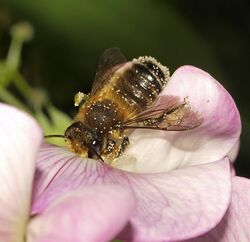Biology:Megachile willughbiella
| Megachile willughbiella | |
|---|---|

| |
| Male | |
| Scientific classification | |
| Domain: | Eukaryota |
| Kingdom: | Animalia |
| Phylum: | Arthropoda |
| Class: | Insecta |
| Order: | Hymenoptera |
| Family: | Megachilidae |
| Genus: | Megachile |
| Species: | M. willughbiella
|
| Binomial name | |
| Megachile willughbiella (Kirby, 1802)
| |
| Synonyms | |
|
Megachile atriventris Schenk 1853 | |
Megachile willughbiella, Willughby's leaf-cutter bee is a species of bee in the family Megachilidae.[1] It was described by the English entomologist William Kirby in 1802; he named it in honour of the ornithologist Francis Willughby.[1][2]
Description
Megachile willughbiella is a leafcutter bee found in gardens and brownfield areas especially in cities. The nest is built in soil or in wood; the cells are made of leaves. The species has kleptoparasites from the leafcutting cuckoo bee genus Coelioxys, such as C. quadridentata, C. rufescens and C. elongata. Pollen is collected from a wide variety of flowers including Asteraceae, Fabaceae and Onagraceae, with a preference for Campanulaceae (bellflowers).[3]
Distribution
The species is widely spread across western Europe between Finland, Lithuania and Spain, including Britain and Ireland. In Britain it is one of the most commonly recorded leafcutter species; it is absent from the north Midlands and from mid- and north Wales, but occurs from Cornwall all the way to Inverness, becoming scarcer with latitude.[3]
References
- ↑ 1.0 1.1 "Megachile". BioLib. 2014. https://www.biolib.cz/en/formsearch/?action=execute&searcharea=1&string=megachile. Retrieved 19 October 2014.
- ↑ Kirby, William (1802) (in Latin). Monographia apum Angliae. 2. Ipswich, UK: J. Raw. p. 233. https://biodiversitylibrary.org/page/10929460.
- ↑ 3.0 3.1 "Megachile willughbiella (Kirby,1802)". BWARS Bees, Wasps & Ants Recording Society. http://www.bwars.com/bee/megachilidae/megachile-willughbiella. Retrieved 8 March 2019.
Wikidata ☰ Q2497092 entry
 |

